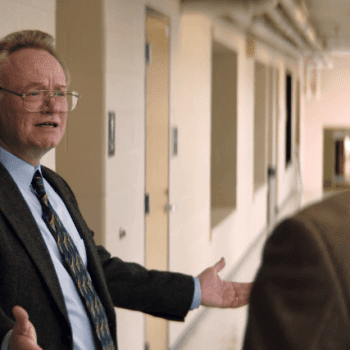A few weeks ago, I had the pleasure of attending the world premiere of Killing Jesus at the Sun Valley Film Festival and speaking to Haaz Sleiman, the actor who plays Jesus. We had met before when I visited the set last year, but back then he still had certain crucial scenes to film, including the crucifixion, whereas when I spoke to him in Sun Valley, he and I had both just seen the completed film for the first time.
An edited version of our interview is now up at Christianity Today. An excerpt:
During the Q&A, you talked about how, when you got the role, you talked to your mother about it. What were her words again?
“Bless you, my son, for playing our prophet, peace be upon him.”
Right. I thought that was interesting, because we’ve heard plenty of talk about how you can’t depict the prophets [in some Islamic traditions], and I know that in Egypt there’s been controversies over films about Joseph and so forth, and it was interesting to hear that your mother encouraged you like that.
Well, in Islam, Jesus is a prophet, and if you look at Mohammed and Jesus and Moses, it’s not like Moses is better than Jesus and Jesus is better than Mohammed. They’re all so highly respected and honored and followed and they’re all there for a reason. Jesus is probably even more important than Mohammed in a way. He came before Mohammed, and I think he’s mentioned in the Koran so many times, people would be shocked.
I’ve heard that there’s an entire chapter on Mary.
Oh absolutely! Absolutely. So it’s an honor for me, as someone who was raised Muslim, to play him. It’s beyond an honor. Now, I know that in Islam, they sometimes say you cannot put a face on Mohammed, and equally they say you cannot put a face on Jesus. I think they came to celebrate humanity and show us how beautiful we are. So yes, absolutely, for me, it is in no way degrading to them, because that’s what they came for—for us. Why else would God send them to us, if that’s your belief? So if we feel like it’s degrading to be human, that is exactly the problem that we’ve been dealing with all our lives, for all the centuries: that we think being human is degrading and unworthy. That is why there’s so much pain and suffering, because we believe that.
Sleiman and I had a good chat about the relationship between humanity and divinity — much of which didn’t end up in the posted interview because it really had nothing to do with the film, and I had a word limit besides — but here’s an excerpt from that:
This would actually dovetail very well with something I’ve been saying over the years, which is that the problem is– I think there are films that try to make Jesus human and they go too far, partly because they associate humanity with weakness, and I think the trick is to recognize– In Christian theology, we would say that Jesus is fully divine and fully human, and fully human would include, I think, part of what you were getting at.
Right. Absolutely. Because God created us. If I’m going to sit here and tell you, “I trust God,” but I don’t trust myself, then I don’t trust God. God created me. He created me! He didn’t create your brains and your heart and your lungs and your intelligence and your divinity within you and the wisdom and the knowingness that you have from birth. We didn’t create that — we didn’t give that to ourselves — God did, if you believe in God, or a source. So then, if you spend your time thinking, “I don’t trust myself but I trust God,” no no no, you don’t trust God, God created you. When you trust yourself, then you trust God.
Okay. That goes a little further than I would, but I understand what you’re getting at.
If you created yourself, then I would understand, okay, yes, yes, you know, but we didn’t. I didn’t give birth to myself. My mother gave birth to me because of whatever source that created her to do that, and then likewise and going back and back and back in time. But what I’m getting at is that it is that oneness of it, the connectedness of the fact that we came from God, he created us. So to trust God, that means to trust in ourselves, to trust our knowingness. And it’s about not judging all of it. Because the minute that you succumb to fear and anxiety and worry, it means you embrace all of it, but when you do embrace all of it and you don’t judge it, you don’t succumb to it. The closest you’ll get to God, ever, in your existence, is measured by how close you get to yourself. Because your connection with God is you. He created you. That is the ultimate connection you have with God, is you. We can agree to disagree, but that’s like the air that I breathe.
For what it’s worth, I would put it the other way around. I would say that–
When you go out and look at nature, do you see God in nature? Do you see God in the trees?
Absolutely.
So why do you take yourself out of the equation?
I don’t. I’m just saying that the closer we get to God, the closer we get to our true selves, which is the reverse way.
Ah! I think the other way around, because he created us.
So, I might quibble with Sleiman over whether we get closer to God by getting closer to ourselves or vice versa, but I wholeheartedly agree with him that Jesus came to show us what full humanity was like, and that cinematic portrayals of Jesus need to suggest this full humanity instead of looking for flaws that they can dwell on.
(When I was growing up, I used to puzzle over the way people said Jesus was fully human except he was without sin. Then one day I realized that Jesus was fully human because he was without sin, and that it is the rest of us who are not fully human — but by looking to Christ and following him, we can become fully human.)
(And just to complicate things even more, the line between “full humanity” and “divinity” of some sort isn’t all that sharp in Christian theology. Numerous saints have said that “God became man so that we might become God,” or “god,” etc.)
As for the film itself, I don’t have a review written yet.
For one thing, I’ve been too busy getting other articles written, such as this one for The Federalist, which uses the release of Killing Jesus — and Sleiman’s role within it — as a hook for looking at films that have moved away from the “white Jesus” stereotype, both here in the English-speaking west and within the Middle East. (And if anyone has more info about that Egyptian movie from the 1930s, please let me know!)
I also feel that I would have to see the film a second time to do it justice, and I just haven’t had the time to do that yet.
But in a nutshell, I would say that I find the film a mixed bag. It’s full of details — like the expanded role for Joanna — that show the filmmakers did their homework. But the very fact that these filmmakers did their homework just makes it all the more puzzling when they change certain details for no apparent reason, like having Jesus crucified to the left of the two thieves rather than between them, or having Judas use his 30 pieces of silver to buy a rope with which to hang himself, instead of returning that money to the priests a la Matthew 27 or buying a field with it a la Acts 1.
Similarly, I really, really like the fact that this may be the only film I’ve ever seen that includes both of the miraculous catches of fish: the one from the start of Jesus’ ministry in Luke 5 and the one from after his resurrection in John 21. It makes perfect dramatic sense to imagine that the second miraculous catch was a call-back to the earlier one, even if none of the gospels treat it that way. But the film hedges its bets on the miracles as a whole, and that creates a strange dissonance in this scene.
For one thing, there is no resurrected Jesus standing by the shore; instead, there is only Peter’s assumption that the spirit of Jesus, or some such thing, has given him this new catch of fish. For another, the film has gone out of its way to show only those miracles that can be written off as coincidence and the like. So is Peter’s renewed faith something to celebrate, as the choice of music and camera angles seem to indicate? Or is the viewer supposed to think that he may be mistaken, even deluded?
I understand why the filmmakers took the approach that they did. I also recognize that the film’s vagueness on everything to do with the supernatural can be traced back to the original book by Bill O’Reilly and Martin Dugard, which as I recall keeps the miracles almost entirely offstage, effectively reducing them to rumours and hearsay.* But this approach poses big dramatic and historical problems.
Dramatic, because unlike a history book that can look at people from the outside and tell us what they told each other, a film needs to draw us into the characters by letting us experience what they experience. Instead, we get sequences like the one where Jesus tells John the Baptist he’s going to the desert, and then we see him come back, but we have no idea what happened in between. Did he have an encounter with Satan? Did he “hear voices” like John did? How did his time in the desert affect his awareness of who he was and what he believed God wanted him to do?
And historical, because you simply can’t make sense of the New Testament if you don’t take into account the fact that the earliest Christians claimed that they had seen the resurrected Jesus. Either the Resurrection appearances happened or they didn’t — and how you answer that will have huge implications for how you see the early Church — but this film tries to chart a third course that doesn’t commit to either option.
In any case, I don’t want that to be my last word on this film.
One of the things I like about Killing Jesus is the way it focuses on Jesus’ relationship with his family. We see Joseph talk to a stranger about how he is raising his son. Mary’s cousin Elizabeth gets to meet Jesus, and not just Mary as she usually does in these films. A girl hugs Jesus when he visits his family, and it is possible that she is one of the “sisters” mentioned in the gospels who have never, to my knowledge, been depicted on film before. And then there is the film’s focus on Jesus’ brother James, who does not believe in Jesus (as, indeed, John 7 says he didn’t).
My only complaint is that the film puts James at the scene of the crucifixion, and that this, combined with the film’s implication that James is also a son of Mary’s, gets in the way of Jesus telling John to look after Mary the way he does in John 19.
However, given that Luke 24 does identify the people who discovered the empty tomb as “Mary Magdalene, Joanna, Mary the mother of James, and the others with them”, it’s kind of amusing to see that the film shows Mary Magdalene, Joanna and Mary the mother of Jesus finding the empty tomb with James, who may or may not be her son in this film. It’s a strangely literal yet not literal take on that passage.
And that, once again, just underscores the point I made earlier about the filmmakers doing their homework and making puzzling, gratuitous changes to the story.
But there I go, sounding critical again. So let me just end with this:
I really like some of the physical and cultural details in this film, from the blood that drips from the nails in Jesus’ wrists to the dead lamb carcass that Judas slings over his shoulder after he’s paid for the Passover meal, and I really like Haaz Sleiman’s performance as Jesus. Consider his first scene with Peter: He doesn’t just borrow Peter’s boat, he gets his tools and works on it for a while, and he seems like a reasonably muscular kind of guy. And then he gets into the boat with Peter and prays for a catch of fish — and this is just one of several scenes in which he prays.
This is a Jesus who is fully engaged both physically and spiritually, and as such Sleiman is a worthy addition to the pantheon, as it were, of actors who have put their own unique spin on the Word of God made flesh.
– – –
* The book, incidentally, is sloppy. Like, really, really sloppy.
Sample quote: “The northern portion of this kingdom [Israel] fell in 722 B.C. to the Philistines…” Uh, no, it fell to the Assyrians, who lived to the east of Israel, not to the west a la the Philistines.
Another quote: “Twenty-six generations separate [Joseph’s father] Jacob from Abraham, and at least fourteen separate him from David.” This appears to be a garbled version of Matthew 1, which says there were 14 generations from Abraham to David, 14 from David to the exile, and 14 from the exile to Joseph. The book apparently squishes the last two groups into a single group of 14. But it gets worse: as anyone who knows the Old Testament could tell you, Matthew himself skips over some names (there were actually 18 generations between David and the exile). So this is sloppy and an uncritical reading of the text.
Another quote: “Matthew’s Gospel and the first book of Acts attributes Judas Iscariot’s death to suicide.” That’s sloppy grammatically and scripturally. There is only one book of Acts, and it does not say Judas committed suicide. When I was growing up, the fact that Matthew and Acts gave seemingly contradictory accounts of Judas’s death was one of those things you discussed in Sunday School. So this is pretty basic stuff. It’s kind of shocking that neither the authors nor their editors caught this.
Another quote: “After his body was found missing, the Gospels state that Jesus appeared twelve times on earth over a forty-day period. These apparitions range from a single individual to groups of more than five hundred on a mountain in Galilee.” There’s an awful lot of conflating going on there. For one thing, the “forty-day period” comes from Acts, not the gospels. The appearance to a group of 500 comes from one of Paul’s letters to the Corinthians, not the gospels (and he never says where it happened). Etc.
I could go on, but you get the idea. None of this, however, should reflect on the film. The film is a dramatic work, and does not purport to be history in the sense that the book does. Different standards apply.
– – –
Update: I have substantially rewritten my “non-review” to clarify a few points.













